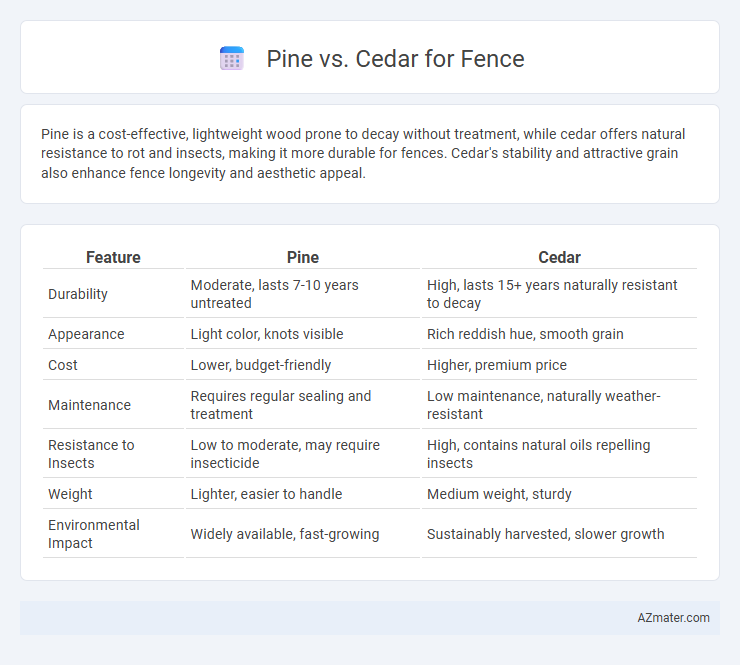Pine is a cost-effective, lightweight wood prone to decay without treatment, while cedar offers natural resistance to rot and insects, making it more durable for fences. Cedar's stability and attractive grain also enhance fence longevity and aesthetic appeal.
Table of Comparison
| Feature | Pine | Cedar |
|---|---|---|
| Durability | Moderate, lasts 7-10 years untreated | High, lasts 15+ years naturally resistant to decay |
| Appearance | Light color, knots visible | Rich reddish hue, smooth grain |
| Cost | Lower, budget-friendly | Higher, premium price |
| Maintenance | Requires regular sealing and treatment | Low maintenance, naturally weather-resistant |
| Resistance to Insects | Low to moderate, may require insecticide | High, contains natural oils repelling insects |
| Weight | Lighter, easier to handle | Medium weight, sturdy |
| Environmental Impact | Widely available, fast-growing | Sustainably harvested, slower growth |
Overview of Pine and Cedar Fencing
Pine fencing offers cost-effective durability with a light color and smooth grain that accepts paint and stain well, making it a popular choice for budget-conscious homeowners seeking a versatile wood option. Cedar fencing is naturally resistant to rot, insects, and decay due to its high levels of natural oils and tannins, providing long-lasting performance and a rich, reddish hue that requires minimal maintenance. Both pine and cedar serve as common fencing materials, but cedar's longevity and natural decay resistance often justify its higher initial cost compared to pine.
Key Differences Between Pine and Cedar
Pine and cedar differ significantly in durability and resistance to decay, with cedar naturally containing oils that repel insects and resist rot, making it ideal for outdoor fencing. Pine is generally more affordable and easier to stain or paint but requires chemical treatment to withstand weather exposure. Cedar's rich aroma and distinctive grain pattern also provide aesthetic advantages, while pine offers a lighter color and a smoother surface for customization.
Durability and Longevity Comparison
Cedar offers superior durability and longevity compared to pine due to its natural resistance to rot, decay, and insect damage, making it a preferred choice for outdoor fencing. Pine, while more affordable, requires chemical treatment to withstand weather conditions and pests, which can reduce its lifespan. On average, cedar fences last up to 30 years with minimal maintenance, whereas treated pine typically endures around 15 to 20 years before needing replacement or significant repairs.
Cost Analysis: Pine vs Cedar
Pine fences generally cost 30-50% less than cedar fences due to the abundance and faster growth rate of pine trees. Cedar offers natural resistance to rot and insects, reducing long-term maintenance expenses and potentially lowering overall lifecycle costs despite its higher upfront price. When budgeting for fencing, consider both initial material costs and projected durability to determine the most cost-effective option for your property.
Appearance and Aesthetic Appeal
Pine fences showcase a light, creamy color with a smooth grain that easily accepts stains and paints, allowing for versatile customization to match various architectural styles. Cedar offers a rich, reddish-brown hue with natural knots and a distinct texture, providing a rustic and elegant aesthetic that ages gracefully to a silvery-gray patina over time. Both woods enhance curb appeal, but cedar's natural oils resist decay and insect damage, maintaining its attractive appearance longer without extensive maintenance.
Maintenance Requirements
Pine fences require regular treatment with preservatives or sealants to protect against moisture, rot, and insect damage, typically needing reapplication every two to three years. Cedar fences naturally resist decay and insect infestation due to their natural oils, reducing maintenance frequency and costs. Both woods benefit from periodic cleaning to prevent mold and mildew buildup, but cedar's inherent durability makes it a lower-maintenance option overall.
Weather and Pest Resistance
Cedar fences outperform pine in weather resistance due to natural oils that repel moisture and prevent decay, making cedar highly durable in wet or humid climates. Pine requires pressure treatment to withstand weather effects but remains more susceptible to warping and rotting over time. Cedar also exhibits superior pest resistance, naturally deterring termites and insects, whereas untreated pine is vulnerable to pest damage unless chemically treated.
Environmental Impact and Sustainability
Pine fences offer a renewable resource option due to their fast growth rates and widespread availability, reducing deforestation pressure compared to slower-growing cedar. Cedar naturally resists rot and insects, decreasing the need for chemical treatments that can harm soil and water ecosystems. Harvesting practices and certification, such as FSC or PEFC for both pine and cedar, play a crucial role in ensuring sustainable sourcing and minimizing environmental impact.
Installation Ease and Workability
Pine fences are easier to install due to their lighter weight and softer texture, allowing for quicker nailing and cutting with basic tools. Cedar requires more effort during installation because of its density, but it resists warping and splitting better, providing long-term durability. Both woods offer good workability, but pine is preferred for DIY projects, while cedar suits professionals aiming for longevity and aesthetic appeal.
Best Use Cases: Which Wood to Choose for Your Fence
Pine fences offer affordability and ease of staining, making them ideal for budget-conscious homeowners seeking a versatile and lightweight option. Cedar, known for its natural resistance to rot and insects, is best suited for long-lasting, low-maintenance fences exposed to harsh weather conditions. Choose pine for decorative or short-term fences, while cedar is preferred for durable, high-quality fencing solutions with enhanced longevity.

Infographic: Pine vs Cedar for Fence
 azmater.com
azmater.com